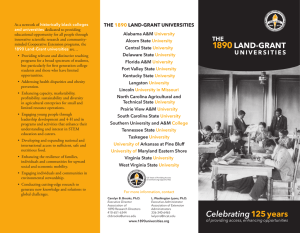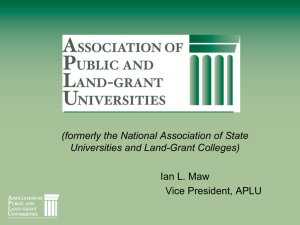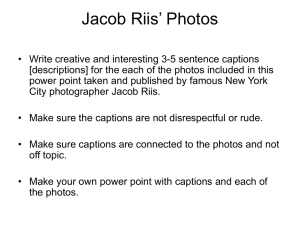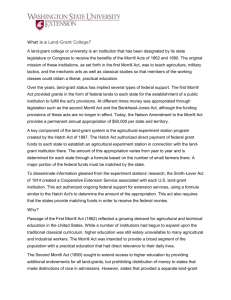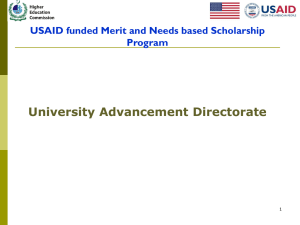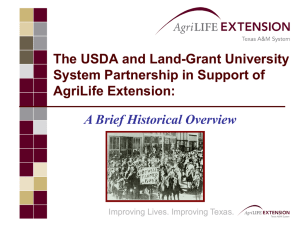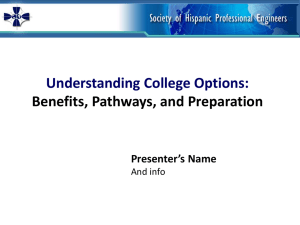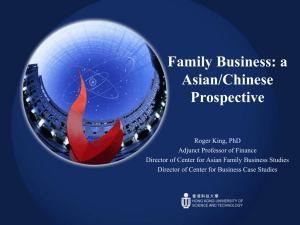Powerpoint - Youth Development & Agricultural Education
advertisement
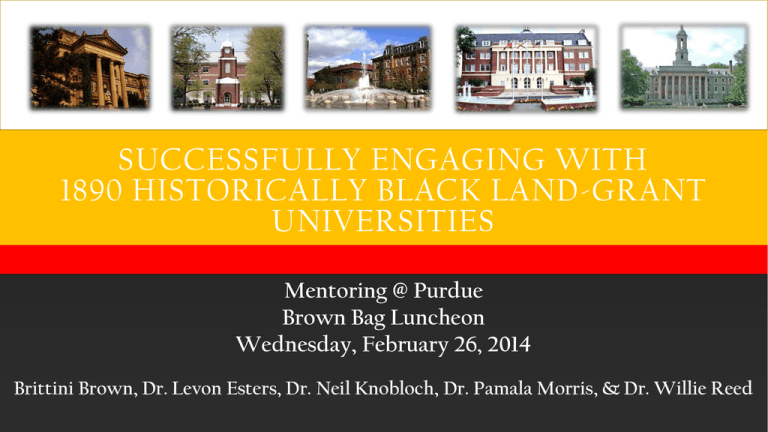
SUCCESSFULLY ENGAGING WITH 1890 HISTORICALLY BLACK LAND-GRANT UNIVERSITIES Mentoring @ Purdue Brown Bag Luncheon Wednesday, February 26, 2014 Brittini Brown, Dr. Levon Esters, Dr. Neil Knobloch, Dr. Pamala Morris, & Dr. Willie Reed CHALLENGES FACING LAND-GRANT UNIVERSITIES Decline of State Higher Education Funding States have cut their spending more sharply on higher education than on prisons or Medicaid (Improving Postsecondary Education Through the Budget Process: Challenges & Opportunities, 2013). Lack of Underrepresented Minorities Obtaining Post-Secondary STEM Degrees Underrepresented minorities (URMs) only account for 7.9% of all science and engineering doctorate-held academic positions in universities and four year colleges (The Road to The STEM Professoriate for Underrepresented Minorities, 2009). How do Land-Grant Universities remain relevant in the 21st century? HOW DO WE MEET THESE CHALLENGES? Multi-institution partnerships can produce high quality programs and opportunities as well as enable universities to do more with less (Transforming Agricultural Education for a Changing World, 2009). State and higher education officials can work together to increase postsecondary access and degree attainment by encouraging institutions to educate and graduate low-income and at-risk students and investing in more vocational and technical education (Improving Postsecondary Education Through the Budget Process: Challenges & Opportunities, 2013). SUCCESSFULLY ENGAGING WITH 1890 HISTORICALLY BLACK LAND-GRANT UNIVERSITIES 1. Recognize the value of the 1862 & 1890 land-grant relationship. 2. Know your partners: Who are the 1890 universities? 3. Seek meaningful, mutually beneficial partnerships. 4. Communicate efficiently & effectively. 5. Understand the dynamic nature of 1890 universities. RECOGNIZE THE VALUE OF THE 1862 & 1890 LAND-GRANT RELATIONSHIP 1862 – 1st Morrill Act – Established land-grant universities in states to teach agriculture and the mechanical arts. 1890 – 2nd Morrill Act – Established land-grant universities in southern states to teach agriculture and the mechanical arts to African Americans. The 1890s did not receive federal funding to conduct agricultural research until 1977 with the Evans-Allen Act. The National Agriculture Research, Extension, and Teaching Act of 1997 provides federal funding for agricultural extension activities at 1890s. Shared mission of research, teaching, and extension, but designed to serve different audiences and have a history of disparate funding. KNOW YOUR PARTNERS: WHO ARE THE 1890 UNIVERSITIES? Located in 17 states and classified as Historically Black Colleges and Universities (HBCUs). Average enrollment: 5,600 Students. 66% of students receive Pell Grants compared to a national average of 46%. 71% of students receive federal loans compared to a national average of 54%. Enroll 6.2% of all students and 52% of all African American students enrolled in land-grant universities. Award more than 20% of bachelor’s degrees in STEM fields. Source: 1890 Land-Grant Universities: Teaching, Research, & Innovation, 2013 SEEK MEANINGFUL, MUTUALLY BENEFICIAL PARTNERSHIPS Seek partnerships that are complementary to your programmatic efforts. USDA Centers of Excellence Association of Research Directors Association of Extension Administrators Invest time in finding the right “fit.” Look beyond the website Schedule telephone and Skype meetings to discuss potential partnerships Consult with colleagues who have an established 1890 relationship Build mutually beneficial partnerships. Ensure everyone is an equal player What’s in it for Purdue? What’s in it for the 1890 partner? COMMUNICATE EFFICIENTLY & EFFECTIVELY Set clear expectations in terms of: Project/program objectives Time commitment Deliverables Short and long term goals Contributions Pick up the telephone Use technological tools Google Docs Microsoft SharePoint UNDERSTAND THE DYNAMIC NATURE OF 1890 UNIVERSITIES Demand of Faculty Time Lack of graduate assistants to assist with courses Institutional Infrastructure Organized differently than 1862s Different research/teaching emphasis Lack of Financial Resources Shrinking budgets Access to materials and equipment Low-Income Students Unique needs WHAT’S IN IT FOR PURDUE? Opportunities include: Building a pipeline of URMs from 1890s to pursue post-secondary STEM based agricultural degrees. Tapping into the expertise and knowledge available at 1890s. Leveraging resources, cost sharing. Coupling knowledge, hence, making grant proposals more competitive. Maintaining relevance as a land-grant t in the 21st century. EXAMPLES OF SUCCESS PANEL DISCUSSION Brittini Brown Doctoral Student MAP - HBCU Outreach Coordinator Youth Dev. & Ag Ed. Dr. Levon Esters Associate Professor MAP Director Youth Dev. & Ag Ed. Dr. Neil Knobloch Associate Professor MAP Co-Director Youth Dev. & Ag Ed. Dr. Pamala Morris Director Office of Multicultural Programs College of Agriculture Dr. Willie Reed Dean College of Veterinary Medicine EXAMPLES OF SUCCESS www.ydae.purdue.edu/lct/hbcu/ EXAMPLES OF SUCCESS PVM will provide clinical experiences for 2-5 students at TUSVM in their 4th year. PVM will expand upon our current Diversity Enhancement Residency training program to include a position for a Tuskegee graduate with funding provided by TUSVM. PVM will provide summer research experiences for 1-2 students at TUSVM between their 1st and 3rd years. Mentoring @ Purdue Department of Youth Development and Agricultural Education Agriculture Administration Building - Room 221 615 W. State Street Lafayette, IN 47907 (765) 494-8423 (T) (765) 496-1152 (F) Email: MAP@ydae.purdue.edu Website: www.ydae.purdue.edu/MAP DISCUSSION QUESTIONS 1. Discuss the importance and the benefits of partnering with 1890 land-grant universities as opposed to other 1862s or HBCUs that are not land-grants? 2. What is the most important piece of advice you can give to a faculty member who is seeking to engage with an 1890 university for the first time? 3. Research partnerships and program development partnerships have different objectives, are there distinct differences in how those partnerships are initiated? 4. What challenges have you faced in engaging with 1890s and how did you overcome them? 5. Audience Question: Are there faculty members present who would like to share their experience of successfully engaging with 1890s?
